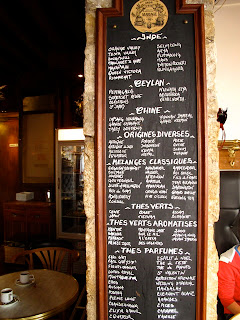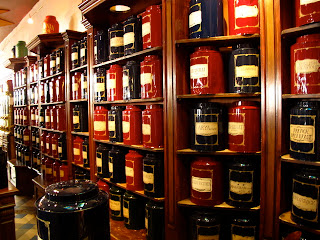 Took advantage of Monday's Pentecost holiday and drove 2.5 hrs to EuropaPark - Europe's answer to Disneyland - just past the Swiss border into Germany...
Took advantage of Monday's Pentecost holiday and drove 2.5 hrs to EuropaPark - Europe's answer to Disneyland - just past the Swiss border into Germany... and rode...
and rode...  The Silver Star, Europe's highest rollercoaster & sponsored by Mercedes Benz, whose cars were formerly all silver colored, thus named. Michael loved it, of course - losing his voice. A mild-mannered Brit from church actually designed the ride.
The Silver Star, Europe's highest rollercoaster & sponsored by Mercedes Benz, whose cars were formerly all silver colored, thus named. Michael loved it, of course - losing his voice. A mild-mannered Brit from church actually designed the ride. The themes are cultural history - educational components arranged around European countries - rather than fantasy-based. A theme park about cultures situated within the very cultures themselves, bringing Europe to Europeans in a way that reminded of California Adventure.
The themes are cultural history - educational components arranged around European countries - rather than fantasy-based. A theme park about cultures situated within the very cultures themselves, bringing Europe to Europeans in a way that reminded of California Adventure.
Beautiful landscaping, attention to detail.



But inventive, as well, creating many different kinds of spaces for different ages (picnic areas, parks, jungle gyms, food everywhere).
The Leonardo da Vinci ride showcased his inventions,


 Constant shows with a mouse mascot - hat tip to Disney.
Constant shows with a mouse mascot - hat tip to Disney. Even a
Even aWestern fantasy and Dixieland band at the entrance.
***
Chicken or the egg?
Europe is also a Disney fantasy - medieval castle, manicured public gardens - but as EuropaPark definitely gets design cues from Anaheim, I began to witness a circular logic whose origin eluded me. Anyway, since this park is on the continent, the food was exact - not like having Italian food in Little Italy; more like, somehow, parts of Italy - not that far - was shipped in.
Anyway, since this park is on the continent, the food was exact - not like having Italian food in Little Italy; more like, somehow, parts of Italy - not that far - was shipped in.
**
But mainly people come for the rides - "hypercoasters" like the Silver Star or the Atlantis:
The lines are cleverly designed to always be changing in vantage point, so it never visually appears unbearable. Many Americans remark, "EuropaPark is like Disneyland, but better." Sounds sacriligeous, but we kind of agreed, although hard to pin down exactly why?
FYI, much more cigarette smoking than in Switzerland or France, which seem to be steering towards smoke-free public spaces.
FYI, much more cigarette smoking than in Switzerland or France, which seem to be steering towards smoke-free public spaces.
 I was annoyed at the constant cutting in line - entire families - as Europeans took advantage of other Europeans' self-contained posture, where an American might object- perhaps the most European aspect of EuropaPark.
I was annoyed at the constant cutting in line - entire families - as Europeans took advantage of other Europeans' self-contained posture, where an American might object- perhaps the most European aspect of EuropaPark.









 The old press.
The old press. The gorgeous scenery.
The gorgeous scenery.
 Our guide, Eric, explained about the ancient dirt giving these old, pinot noir roots a concentrated bouquet, for which the wines of Pommard village and chateau are famous. It is easy to wax poetic, "going Biblical" with grapes turning into wine metaphor: beautiful drink resulting from pruning above and determined digging below of roots
Our guide, Eric, explained about the ancient dirt giving these old, pinot noir roots a concentrated bouquet, for which the wines of Pommard village and chateau are famous. It is easy to wax poetic, "going Biblical" with grapes turning into wine metaphor: beautiful drink resulting from pruning above and determined digging below of roots





 I was startled to learn that one of the Pommard estate owners was Jean Laplanche, famous psychoanalyst whose famous encyclopedia I studied in the heady days of postmodern theory while at Cornell.
I was startled to learn that one of the Pommard estate owners was Jean Laplanche, famous psychoanalyst whose famous encyclopedia I studied in the heady days of postmodern theory while at Cornell. 








 This seller has the only hydraulic cheese slicer!
This seller has the only hydraulic cheese slicer!
 Alex explains the stages of cheese one can buy, as the whey separates. A well-informed and connected Frenchman now, Alex is an academic of sorts, lecturing at NYU and corporate circles on the sociology of food. In a space of an hour, he introduced us to a dozen of the best vendors - grow, raise, slaughter all their own vegetables, fowl, etc. as well as a Michelin restaurant inspector.
Alex explains the stages of cheese one can buy, as the whey separates. A well-informed and connected Frenchman now, Alex is an academic of sorts, lecturing at NYU and corporate circles on the sociology of food. In a space of an hour, he introduced us to a dozen of the best vendors - grow, raise, slaughter all their own vegetables, fowl, etc. as well as a Michelin restaurant inspector.

 Japanese sense of aesthetic refinement and perfection nicely dovetails with the goals of French cuisine. These delights below are from a new pastry chef and his Japanese wife. Those are viles of RUM.
Japanese sense of aesthetic refinement and perfection nicely dovetails with the goals of French cuisine. These delights below are from a new pastry chef and his Japanese wife. Those are viles of RUM.
 Alex with friend Gilliam, a wry Air France pilot, whose 17th century old town apartment provided the setting.
Alex with friend Gilliam, a wry Air France pilot, whose 17th century old town apartment provided the setting.
 Michael seemed to enjoy handling the rabbit's organs(!), as well as prep work. Jack and Beth look on.
Michael seemed to enjoy handling the rabbit's organs(!), as well as prep work. Jack and Beth look on.





 Alex gave us a far more engaged session, culturally speaking, but we would've preferred a more hands-on event.
Alex gave us a far more engaged session, culturally speaking, but we would've preferred a more hands-on event.





 The Eiffel Tower & steam-powered ships were successfully transformed into industrial icons, romanticized the way we experience America's grand old cinema venues or locomotives or tall ships; the powerful charm of Parisian culture lies here, too, I think - markedly different than the medieval lure of most European town centers.
The Eiffel Tower & steam-powered ships were successfully transformed into industrial icons, romanticized the way we experience America's grand old cinema venues or locomotives or tall ships; the powerful charm of Parisian culture lies here, too, I think - markedly different than the medieval lure of most European town centers.